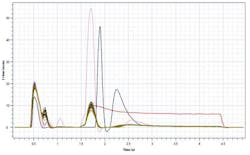Manufacturing 4.0 means different things to different people. But the essential premise revolves around data—data to drive quality assurance, data that allows for greater automation, data that allows an artificially intelligent machine to assess a situation and decide on a new course of action.
As a machine builder, this is not a trend you can afford to ignore. It’s much easier to have this intelligence incorporated into a line as it is being built than bolted on afterward. Manufacturers would rather purchase a complete turnkey solution than incur the time and expense of procuring equipment, hardware, and software from different vendors and then trying to integrate it all together.
Whether it’s called Manufacturing 4.0 or the Industrial Internet of Things, the core theme is data to drive quality assurance. Quality is king, especially in discrete manufacturing industries that make big-ticket or premium items like automotive, off-highway, and medical.
With industries such as these, Manufacturing 4.0 has substantially raised expectations in the marketplace. There is a growing emphasis on being able to provide granular proof of compliance (to design and performance specifications and to any regulatory requirements) and traceability to track the origin and extent of a defect.
What do manufacturers need from their lines and plants as a result? All relevant production data, collected and indexed by part serial number into comprehensive birth history records, and stored in a single database—where it can be correlated and analyzed by anyone, anywhere in the organization, at any time.
1. This screenshot from Sciemetric Studio—a family of next-generation analytics software for smart manufacturing—shows the complete birth history for a part as it underwent multiple production processes.
What does this deliver? Near real-time insight, enterprise-wide. Someone in charge of a plant in Detroit can monitor what is happening at overseas plants at the same time. This instills confidence that every line is running as it should. Near real-time insight can make anomalies that point to a problem easy to spot and address at an early stage. This results in higher first-time yields, and lower scrap and rework rates.
Parts manufacturers, equipment suppliers, and tool builders that natively adopt into their manufacturing processes the connectivity, traceability, and advanced analytics set out by Manufacturing 4.0 to deliver on these needs will quickly win the confidence of their OEM customers.
Why? Because they will help their customers to reduce costs, increase profitability, and enhance their reputation in the marketplace. If you can sit in a sales meeting armed with that kind of messaging, your competition will be heading for the door with tail tucked.
But how do you do it? Not so long ago, machine builders had only one recourse when a customer came along with a requirement to collect and database production data for quality assurance. They would have to design, purchase, assemble, code, install, pipe, wire, and test a scratch-built solution. And starting from scratch always means greater risk of failing to deliver on time and on budget. Some machine builders still believe that this kind of DIY approach is the way to go, that it will somehow save them money versus buying a common standard solution. But in the end, it usually only causes them internal problems, big headaches and missed deadlines.
Common standard solutions do exist: instrumentation, databasing, and data analytics tools that are economical, flexible, and designed to be agnostic. They can work with and ingest data from the production line equipment and systems of other vendors.
The Results
2. Consolidating data from multiple processes into a single source makes it easier for front-line workers and plant managers to access the information they need.
By offering manufacturers the capability to harness the full spectrum of data science to collect and analyze digital process signatures, scalars, machine vision images, and data, you will help them to:
Troubleshoot and dial in new equipment and new lines faster. This is particularly valuable for large OEMs that may be launching lines with 50, 100, or even 500 machines strung together. One weak link will hold up the entire line.
Bottlenecks can be identified immediately. Root causes can be diagnosed and eliminated systematically. New control limits can be verified and easily adjusted. Process signatures from the new line can be matched against existing ones to give a strong indication of conformance.
Compare and manage performance stations anywhere. Innovations in one plant can be reliably applied to other plants, providing an increase in yield. For example, one company was able to launch new lines around the world an average of four times faster—for an estimated average savings of $4 million per plant—using its data in this way.
In addition, you will help your customer prevent the same problem from occurring twice. Once the root cause of a production or quality issue has been identified ,the comparable process, test, or machine on other lines or at other plants can be adjusted before they can suffer the same problem. Learn the lesson once, and then apply it as often as needed for continuous improvement.
Manufacturers can also avoid situations where additional parallel process or test stations must be installed and staffed to maintain quality and production quotas. Any insight from the data that enables seconds to be shaved from each cycle of a process or test can yield substantial savings in equipment and staffing costs.
Set up new test systems quickly with objective data for limit setting and management. In one example, it took weeks for the company to find the correct test limits for an automotive sensor—it even took days for a simple calibration. By adding signature analysis capability to the test system already installed on the line, scalar data and the associated signatures could be collected and analyzed together. Data analytics software did the work to automatically calculate statistically based limits and the correct processing algorithms within 30 minutes.
Now, how much grief would it have saved this manufacturer if that capability had been baked into the test system by the builder in the first place?
3. This figure shows 109 runs of a vacuum flow test. Four of those runs are clearly outside the test limits, which means those parts are defective. The box on the zoomed-in image shows where the test limits should be set to most accurately determine pass/fail results.
This is Just the Beginning
The greatest benefits accrue over the life of the line to drive continuous improvement. Don’t overlook the fact that the benefits that you can deliver to your manufacturing customers to improve their operations can be applied to your own plant floor.
By equipping your builds with sensors such as load cells, temperature, position, pressure sensors, and/or displacement gauges, you can track the consistency and quality of each station and process. Every time an operation is test run, the full process signature is captured. This gives immediate insight to spot anomalies that point to issues with calibration, alignment, pressure, angle, and whatever parameters are relevant.
The more data you collect, the clearer the picture becomes. More data and more insight adds value at every stage of the build.
For example, an automotive electronics manufacturer ran into a problem with the sealant dispense operations on its new production line for engine fuel control modules. By analyzing the collected signature data, the engineers determined that a problem with the system dispensing too slowly was the fault of a programmable logic controller that communicates over an Ethernet protocol.
With the right common standard solution, it took just 30 minutes to troubleshoot the problem, versus several weeks. The lesson here is that the builder could have caught and corrected this problem before that dispense system fired up on the manufacturer’s production line.
In Conclusion
As the precepts of Manufacturing 4.0 and the Industrial Internet of Things gain acceptance with OEM manufacturers globally, the need for quality data management is trickling down to machine builders and integrators. They are finding themselves providing various levels of data management to help improve quality and station utilization, achieving greater productivity and profitability in their customers’ plants.
The most efficient and cost-effective way to deliver on these requirements is to seek out a proven, common standard solution and incorporate it into the build. The result is reduced risk, more business, better margins, and a sharper competitive edge for you, the builder.
Derek Kuhn is senior vice president of Sciemetric. He brings substantial experience in the automotive market and in the trends and technology associated with the Internet of Things (IoT).




